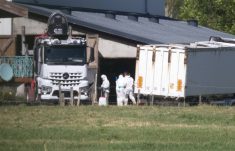By Theopolis Waters
CHICAGO, Jan 24 (Reuters) – Chicago Mercantile Exchange live cattle futures moved lower on Friday on investor caution before the U.S. Department of Agriculture’s monthly cattle-on-feed report at 2 p.m. CST, traders said.
Most analysts polled by Reuters believe placements of cattle in U.S. feedlots in December likely dropped 2.3 percent from a year ago due to ample grazing land.
Some investors sold futures with the view that processors will balk at spending more for cattle if retailers push back against high beef cost, which helped improve packer margins.
Read Also

U.S. livestock: Cattle fall sharply as Trump says he’s working to lower beef costs
Chicago cattle futures fell sharply on Friday after U.S. President Donald Trump said his administration was working to lower the…
Beef packer margins for Friday were estimated at a positive $90.65 per head, compared with a positive $127.95 per head on Thursday and a positive $53.60 a week ago, as calculated by HedgersEdge.com.
The morning’s wholesale choice beef price was $238.27 per hundredweight, down 28 cents from Thursday, and select cuts gained 29 cents to $237.22, according to USDA data.
This week, cash cattle in the U.S. Plains sold up to $150 per cwt., surpassing last week’s $144 record, feedlot sources said.
Fewer cattle are available after packers shut down packing plants over the year-end holidays, and recent waves of wintry weather slowed down cattle weight gains.
February live cattle closed 0.525 cent per pound lower at 143.400 cents, and April ended down 0.500 cent to 140.100 cents.
CME January feeder cattle closed up 0.325 cent per lb. to 170.000 cents as it tracked the exchange’s feeder cattle index at 170.23 cents.
Weak live cattle futures pressured remaining CME feeder cattle contracts.
March finished at 168.875 cents, 1.000 cent lower, and April closed 0.875 cent lower at 169.475 cents.
HOGS UP AS TEMPS FALL
CME hog futures gained in anticipation of higher cash prices as brutal cold grips the Midwest hog-growing region, traders said.
USDA’s morning’s direct hog market prices were not available. Hogs in the Midwest traded steady to $1 per cwt. higher, according to hog dealers.
They said some packers canceled delivery of hogs from producers who kept swine buildings closed to retain heat. Hog farmers fear losing hogs to frostbite while being trucked to packing plants.
Processors that were closed for Monday’s holiday are expected to makeup the downtime on Saturday, which helped underpin cash prices.
Spread traders bought April futures and sold February and deferred months. April will become the new lead month after spot February expires on Feb. 14.
Speculators bought CME summer hog futures in the belief that the spread of the Porcine Epidemic Diarrhea virus (PEDv), which is fatal to baby pigs, could dent hog supplies at that time, analysts and traders said.
February hogs closed at 86.375 cents per lb., up 0.800 cent, and April ended at 94.025 cents, 1.075 cents higher.














